Modifications F-5 :
The F-5A "Freedom Fighter" and the Two-Seat F-5BThe F-5A was a basic aircraft design that was optimized for air-to-ground
operations with limited air-to-air serviceability. This was mostly due to the
lack of any onboard fire control radar system to help identify, track and engage
aerial targets with guided/homing missiles all her own. The F-5A was powered by
a pair of General Electric J85-GE-13 turbojet engines featuring 2,720lbs of
standard thrust and 4,080lbs of thrust with afterburning (raw fuel pumped into
the engine to produce a short burst of power and, therefore, heightened speed
and performance). Maximum speed was Mach 1.4 / 925mph (36,000 feet) with a
service ceiling up to 50,500 feet. Maximum range on internal fuel was around
1,387 miles. Standard armament included 2 x M39 20mm cannons on either side of
the nose assembly. Two AIM-9 Sidewinders were exclusively fitted to the
wingtips. There were four underwing and a single underfuselage hardpoint for the
carrying of bombs, rocket pods and missiles - up to 6,200lbs of ordnance.
External fuel stores could replace some of the weapons stations.
The F-5B development stemmed from the F-5A before it and was nothing more than
two-seat "combat trainer" with the purpose of training future F-5 pilots while
also retaining some of her inherent combat value. With the addition of the
second instructor's cockpit came the loss of one of the M39 cannons and some
internal space while introducing a new, revised longer nose assembly.
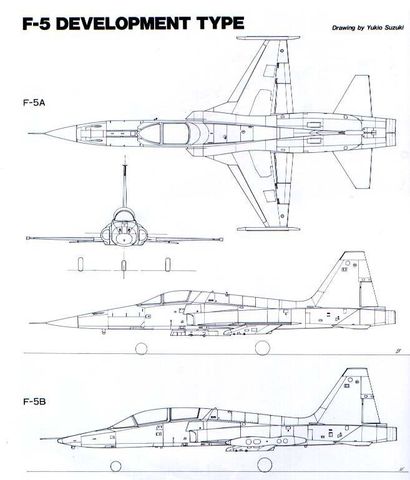
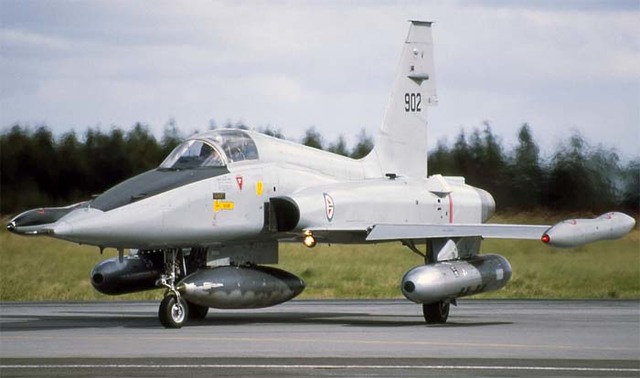

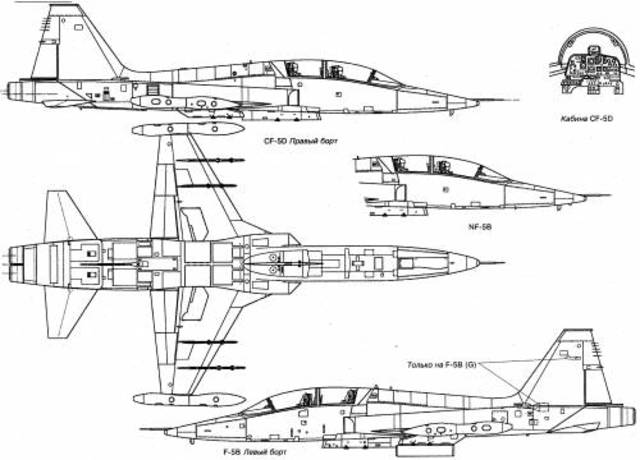
 F-5C
F-5C With the United States embroiled in the Vietnam War, a single squadron of F-5A
was selected by the USAF for combat evaluation in October of 1965. The
evaluation lasted from October of 1966 to March of 1967 with the name of "Skoshi
Tiger" (Little Tiger) assigned to these program F-5s. At least 12 initial
airframes were enlisted for action and served with the 4503rd Tactical Fighter
Squadron and a handful more soon joined the effort. Modifications to these
"Tigers" included the installation of better in-cockpit instrumentation,
increased armor protection and support for "probe and drogue" in-flight
refueling. The changes necessitated a new designation which gave birth to the
F-5C mark. These F-5Cs operated under the banner of the 3rd Tactical Fighter
Wing out of Bien Hoa and Da Nang Air Base and covered some 2,600 missions over
Vietnam and Laos with only one airframe was lost to action.
Despite the solid showing (in both air-to-air and air-to-ground actions) during
the conflict, the USAF still shown no interest in procuring the Northrop
product. However, the combat evaluation did serve a political motive as it
showcased the viability of the F-5 as a multi-role platform to interested
nations "still on the fence". After the USAF program in Vietnam was completed,
the modified F-5Cs were delivered to the South Vietnam Air Force. With the fall
of the city of Bien Hoa in South Vietnam, some of these F-5Cs were reconstituted
back into service with the Communist North and examples were further shipped to
the Soviet Union for intense study.

 F-5E & F
F-5E & F The F-5E model retained much of the qualities that had made the previous F-5A a
global market success. Special attention was applied to improve performance by
fitting a pair of General Electric J85-21/21A series engines, each rated for
5,000 thrust output. The service ceiling was slightly raised to 51,800 feet and
range was improved to 1,543 miles. The fuselage was therefore enlarged and
lengthened to accommodate the new powerplants as well as extra stores of
internal fuel to help increase operational range. Avionics were upgraded with
the Emerson Electric AN/APQ-153 series radar and various other customer-required
systems could further be installed as needed - in a way making the F-5E
something of a modular platform. Maneuverability was enhanced by the addition of
leading edge extensions along the wings which produced a larger wing surface
area as a result. The twin M39 cannons were retained but upgraded to the M39A2
series and ordnance load was increased to 7,000lbs. First flight of the F-5E
variant occurred on August 11th, 1972 and the type was formally designated as
the F-5E "Tiger II".
As in the F-5A development before it, the F-5E was also branched out into a
two-seat version designated as the "F-5F". With the addition of the second
(instructor's) cockpit, one of the M39A2 internal cannons was deleted and the
nose was lengthened. The Emerson Electric AN/APQ-157 radar (based on the
aforementioned AN/APQ-153 series) was a standard fixture. Later versions were
offered with the upgraded Emerson Electric AN/APG-69 series radar system but
this modernization proved cost-prohibitive to all customers except the USAF.
Like the F-5A earlier, the F-5E was also developed into the single-seat RF-5E
"Tigereye" photographic reconnaissance variant.
The USAF received their first F-5E models with the 425th Tactical Fighter
Squadron though it was mostly foreign parties that took an interest in Tiger II
procurement with some 20 air forces around the world went on to field the type.
The 425th TFS utilized their new F-5Es to train foreign forces.
In all, 792 F-5E models were produced by Northrop facilities. Northrop also
added manufacture of 140 F-5F two-seat combat trainers and a further 12 RF-5E
Tigereyes. Taiwan produced the F-5E/F-5F in quantity, totaling some 308 aircraft
deliveries in all. Switzerland also undertook local-license production of these
new versions and produced 91 F-5E and F-5F models. South Korea added 68 local
examples.


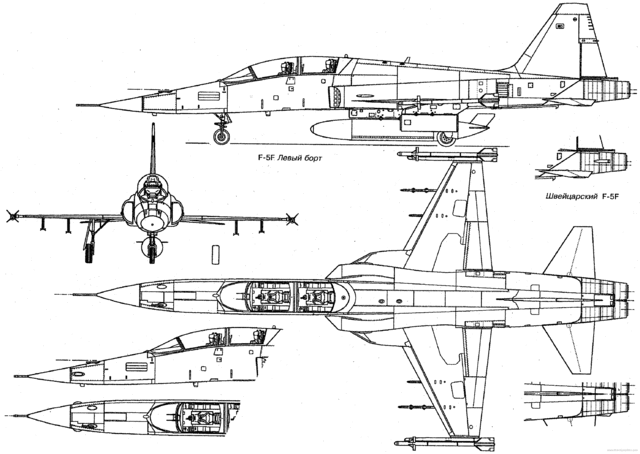

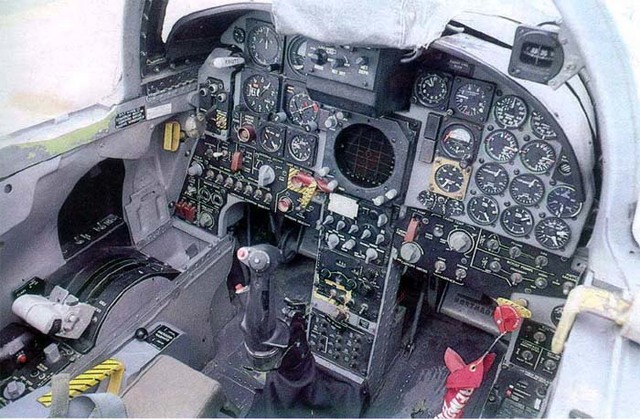 F-5G
F-5G The global success of the F-5 series prompted a newer, single-engine,
single-seat model to appear. This was a modified F-5E initially designated as
the F-5G. Engine output was increased by as much as 80 percent from the original
design and other revisions made for a more potent adversary. Ultimately, the
program grew apart from her F-5 origins enough that she received the all-new
F-20 "Tigershark" designation. However, the F-20 was up against stiff
competition with the arrival of the do-everything General Dynamics F-16 Fighter
Falcon lightweight fighter of similar scope but broader capabilities.
Additionally, the USAF's decision to pass on procurement of the Tigershark
essentially doomed it for global sales - its local endorsement proved quite
vital in the global market.
General characteristics

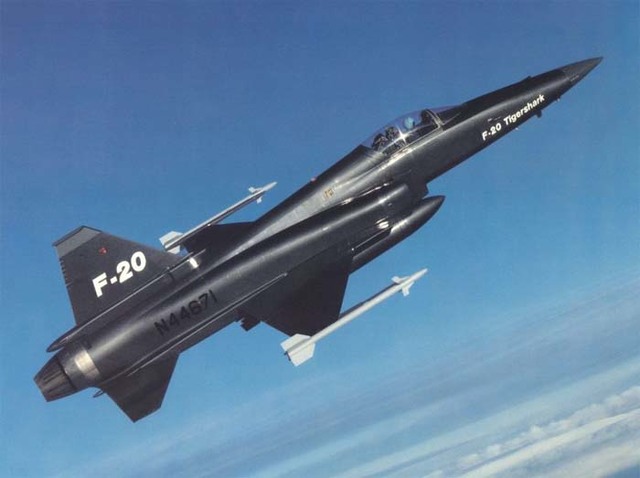

General characteristics:
Crew: F-5A,C,E,G:
1 F-5B,E:
2 F-5A,C,B F-5E,F F-5G
Length: 14.38 m 14.68 m 14.19 m
Wingspan: 7.70 m 8.13 m 8.13 m
Height: 4.06 m 4.06 m 4.22 m
Wing area: 15.79 m² , 17.28 m² 18.60 m²
Empty weight: 3667 kg 4392 kg 5357 kg
Max. takeoff weight: 9379 kg 10922 kg 12474 kg
Powerplant: 2 x General Electric 2 x General Electric 1 x General Electric
J85-GE-13, 12.10 kN each J85-GE-21B, 22.24 kN each F404-GE-100A, 8165 kg
Performance:
Maximum speed: 1487 km/h 1760 km/h 2124 km/h
Range: 898 km 1083 km 713 km
Practical ceiling: 15390 m 16460 m 16500 m
Rate of climb: 8748 m/min 9900 m/min 16100 m/min
Armament:
Guns: 2 x 20 mm Ford M39A2 into the nose
Container with 30mm
cannon
Rockets: 4 x AGM-12 4 x AGM-65 4 x AGM-65
4 x AIM-9 4 x AIM-9 4 x AIM-9L
2 x AIM-7F
Bombs: 2 x M-117 2 x M-117
3 x MK-82 9 x MK-81 9 x MK-81
9 x MK-81 3 x MK-82 3 x MK-82
Unguided missiles: 4 x LAU-3A 4 x LAU-3A 4 x LAU-3A
4 x LAU-10A 4 x LAU-10A 4 x LAU-10A
|
 Author
Topic: Nortrop F-5 Freedom Fighter (Read 5567 times)
Author
Topic: Nortrop F-5 Freedom Fighter (Read 5567 times)


